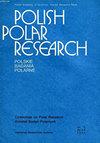斯匹次卑尔根西南部Kvartsittsletta隆起的海洋阶地上的遗迹和当代土壤
IF 0.8
4区 地球科学
Q4 ECOLOGY
引用次数: 0
摘要
:北极地区的土壤因其对气候变化的高度敏感性而备受关注。弗罗茨瓦夫大学Baranowski研究站附近的Kvartsittsletta海岸构成了一系列不同年代的海阶地,上面覆盖着不同比例的海滩材料。它是几种发育中的土壤类型的母体材料。尽管现代土壤形成过程强度较低,但土壤覆盖具有高度多样性的特点。土壤性质主要由地质和地貌因素形成,这些因素叠加了气候和生物的影响。土壤的发育程度通常是其相对年龄的指标。本文强调了岩性和微地形对其他土壤形成因素的主要影响,包括母体材料暴露于外部因素的持续时间。Kvartsittsletta最高(最古老)阶地台阶上的土壤很少显示出除低温扰动之外的土壤形成过程的深层迹象。在最年轻的阶地上,观察到与相对温暖的气候相关的土壤过程的深层影响,包括形成层的出现。它们在北极地区的存在携带着重要的环境信息,可能与气候变化研究有关。本文章由计算机程序翻译,如有差异,请以英文原文为准。
Relict and contemporary soils on uplifted marine terraces of Kvartsittsletta, SW Spitsbergen
: The soils of Arctic regions are of great interest due to their high sensitivity to climate change. Kvartsittsletta coast in the vicinity of the Baranowski Research Station of the University of Wrocław constitutes a sequence of differently aged sea terraces covered with different fractions of beach material. It is a parent material for several developing soil types. Despite the low intensity of the modern soil-forming processes, the soil cover is characterized by high diversity. Soil properties are formed mainly by geological and geomorphological factors, which are superimposed by the influence of climate and living organisms. The degree of development of soil is usually an indicator of its relative age. This article highlights the dominant influence of lithology and microrelief over other soil-forming factors, including the duration for which the parent material was exposed to external factors. The soils on the highest (oldest) terrace steps of the Kvartsittsletta rarely showed deep signs of soil-forming processes other than cryoturbations. On the youngest terraces, deep-reaching effects of soil processes associated with a relatively warm climate, including the occurrence of cambic horizons, were observed. Their presence in Arctic regions carries important environmental information and may be relevant to studies of climate change.
求助全文
通过发布文献求助,成功后即可免费获取论文全文。
去求助
来源期刊

Polish Polar Research
ECOLOGY-GEOSCIENCES, MULTIDISCIPLINARY
CiteScore
2.00
自引率
7.70%
发文量
0
审稿时长
>12 weeks
期刊介绍:
The quarterly Polish Polar Research edited by the Committee on Polar Research of the Polish Academy of Sciences is an international journal publishing original research articles presenting the results of studies carried out in polar regions.
All papers are peer-reviewed and published in English.
The Editorial Advisory Board includes renowned scientist from Poland and from abroad.
 求助内容:
求助内容: 应助结果提醒方式:
应助结果提醒方式:


